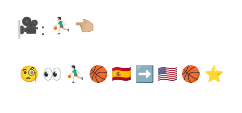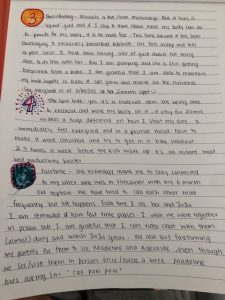Recorded using dictation (voice-to-text) in Notes on the iPhone: A Birth Story for my Daughter
Oh my dear this is a story about the day that you were born and it wasn’t too long ago when you came into this big beautiful world and now you’re almost 2 months from the day was April 5, 2022 and mom going with the day that I was going to go into the hospital to be induced the morning of I called the hospital at 6 AM to see when I can come in to get started they said I could come in right away but I wasn’t ready yet because I had to get big sister Madeline already to go to daycare and make sure that she was settled with her grandparents so we went into the hospital around 8 AM me and your dad they were all packed and ready to stay for a few days because we weren’t sure what to expect but sure enough you were or you came in a timely manner to get started mommy got hooked up with lots of tubes and IVs to make sure that you came out safely and to get the contraction started it took a bit of waiting and I got really hungry in between but I wasn’t allowed to eat any solid food so all I ate was bone broth fast forward two hours later and the contraction started to come contractions are sharp pains in the belly area that tell me that you’re getting ready to come the doctors checked to see if I was ready to push and I wasn’t quite there yet I was only 2 cm and I need to go eight more centimetres before I could start pushing so we waited some more in the meantime dad and I walked around the room and watch the movies and we talk to one another around four hours later the contractions started to come closer and more painful that’s when Dad suggested that mom gets an epidural so that it wouldn’t hurt so much and that was it The best decision he made the anaesthesiologist came in and put a giant needle in my knees back it was a little painful and it felt like a bee sting but the after effect was wonderful that meant I couldn’t feel the pain as much as a contraction started to come closer together at this point it was mid afternoon around 2 PM and I told daddy to go home to see Madeline for a little bit because I was only still 3 cm dilated and your aunt Caroline was there to take over just as dad left the pain started to really come even though I had an epidural and guess what I was 9 cm and dad wasn’t there I was almost ready to push so we need you to call dad and he had to turn the car aroundAnd come right back he made it just in time for the delivery and you were amazing and three pushes you were out and you were absolutely perfect they gave you to mommy and we looked at each other for the first time you with your tiny cry and I knew right then and there that you were exactly who and where you needed to be
How does the text deviate from conventions of written English? What is “wrong” in the text? What is “right”?
Efficient, but inaccurate. Accessible, yet incoherent. This is my initial feedback while reading the unedited written version of my oral story. Writing has become a skill that requires the utilization of proper conventions to create a clear, concise piece of work. Other than correct spelling and application of some grammatical rules, the text was missing basic conventions including punctuation and capitalization which had a large impact on how the genre was perceived. These grammatically correct statements are derived from rules of natural language foremost and translated to text (Ong, 2002). The structure and arrangement of words were directly dictated into typed writing on my iPhone in Notes to generate one massive run-on sentence, which was morphologically intact but fell apart with the construction of sentences (syntax). As a result of the lack of structural constraints, it was challenging to make sense of what was read and difficult to follow along with the organization of thought. There were instances that my spoken words were misinterpreted, for example, it read the phrase ‘all ready’ as the adverb ‘already’. As I read through, I also noticed errors as a result of pauses during speech which lead to an increased number of the word ‘and’ to try to connect thoughts together.
What are the most common “mistakes” in the text and why do you consider them “mistakes”?
Since writing is considered itself to be a technology (Haas, 2013), it follows a set of technical rules in the English writing system. Gnanadesikan (2011) states that “writing is a transformation of language, a technology applied to language, not language itself.” This voice-to-text task did just that, by transforming my spoken story into a text version with aspects of my ideas that were lost in translation. More specifically, the absence of any punctuation and paragraphing disregarded the meaning of words and emphasis on certain elements of the story. Take for example, quotations in the text that assimilated with the body of the text that lost its purpose. The reader is unable to identify who is speaking in reference to the narrative. These mistakes enable the words to lose their value. Simply because the words are translated onto a page does not mean that it inherently makes sense. In Gnanadesikan (2011) chapter “The First IT Revolution”, he speaks about writing systems and differentiates between language and speech. He further explains that writing is able to capture language but fails to include information about intonation and emotional content that is found in speech (p9). This is similar to the dichotomy of speech and writing presented by Plato in Haas (2013, p7) and holds true to the application of the voice-to-text software.
What if you had “scripted” the story? What difference might that have made?
In Schmandt-Besserat (2009), “Origins and Forms of Writing”, David Olsen makes the argument that our ability to reflect on ourselves is derived from writing, not speech. Having a scripted story would support this argument by producing a more coherent and organized text with precision in the messaging (Gnanadesikan, 2011). A script would allow for a more thoughtful construction of words to communicate using language more effectively with succinct vocabulary. In my oral story example, it was easy to recall the main details of the day my daughter was born, however, when the task was complete there were many moments that I wanted to go back to add to. On the other hand, a scripted story may limit creativity and imagination rather than allowing the thought process to flow naturally in an unscripted, conversational manner.
In what ways does oral storytelling differ from written storytelling?
A translation of time into space. Gnanadesikan (2011) eloquently describes the process of writing and how the act itself has shaped our language. Written storytelling has the ability to transcend time and remain unchanged throughout history in its physical nature or ‘material’ form (Haas, 2013). A text, and all of its ideas, that was written hundreds of years ago is the same work that exists today. I believe there is also a sense of formality when comparing oral and written storytelling. To have your ideas written provides permanence whereas orally speaking is more transient, once the words are heard it can easily be forgotten. This connects to Gnanadesikan’s (2011) statement that “…writing is worth more than speech.” There is an art to storytelling, both oral and written, which uses languages to evoke emotions in various contexts and for different purposes. Ong (2002) elaborates on the origins of the word ‘rhetoric’ as speech art and how writing enhances oral speaking. Furthermore, Ong (2002) argues that “Writing can never dispense with orality” (p4). I think this is profoundly noticeable with respect to the integral role that oral storytelling has in Indigenous cultures to transmit information and their histories throughout generations. In an effort to keep their language alive, there must be a concerted effort amongst generations to share and teach one another through the spoken language and storytelling. In the CBC article (Hadley, 2019), this is applied to 21st century learners through an app to “carry Indigenous languages into the future”. Furthermore, oral storytelling is subject to the interpretation on the receiving end and requires a commitment to continue its legacy.
References:
Gnanadesikan, A. E. (2011).“The First IT Revolution.” In The writing revolution: Cuneiform to the internet. (Vol. 25). John Wiley & Sons (pp. 1-10).
Hadley, A. (2019, January 11) New Indigenous language app targets ’21st century’ learners. CBC News. https://www.cbc.ca/news/canada/thunder-bay/indigenous-language-app-1.4970376
Haas, C. (2013). “The Technology Question.” In Writing technology: Studies on the materiality of literacy. Routledge. (pp. 3-23).
Ong, W. (2002). Orality and literacy: The technologizing of the word. New York; London: Routledge.
Schmandt-Besserat, D. (2009). “Origins and Forms of Writing.” In Bazerman, C. (Ed.). Handbook of research on writing: History, society, school, individual, text. New York, NY: Routledge.



